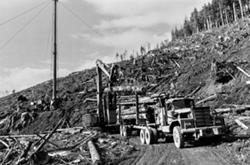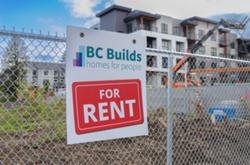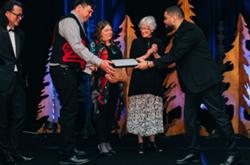We live in the coastal temperate rainforest. Moss-laden spruce branches arch and bend earthward outside our back windows. Fir trees reach over the small bank between our house and the creek where we get our drinking water. A pair of giants guard our cabin’s front corner post. We face the beach and ocean in the midst of Hesquiaht territories, on the west coast of what is now known as Vancouver Island.
The rainforest has been a constant here. It feels as enduring as the sea, as the waves that continue to lap and pound the shoreline. Yet, the resource extraction companies have already come for the nearby mountainsides. Large swaths of shorn hillsides spent barren decades before finally beginning to show inklings of new green growth. The many landslides remain bare, incapable of holding the slightest hint of anything other than scoured rock. I continue to expect the logging companies to return. They threaten. I know from past experience that it is unwise to ignore them.
Climate change is both a consequence of and larger than what the resource-taking industry has done here in Hesquiat Harbour. Drought, extreme heat, torrential rains, floods, unpredictable storm patterns and wildfires are already here. The political manoeuvrings and scientific analyses that caused these harms — and those that aim to mitigate them — take place far away from here, and we are left alone to deal with the on-the-ground reality.
Fifty kilometres down the coast from us, Tofino’s precipitation records show an average annual rainfall of
What becomes of the rainforest when it no longer rains? When do we slip below the level at which a rainforest can sustain itself as a rainforest? When is there simply not enough rain? When is too much heat simply too much?
By August, the creek alongside our home was too low and slow moving to flush out the salt water that enters it during the higher tides.
The bottom section of creek became a sort of lagoon. Where my husband has been able to get fresh drinking water throughout his lifetime, the water was now too salty to drink.
For the first time, we had to drive our utility vehicle farther upstream, down an old logging road, and walk the trail down to the upper creek waters to fill our water jugs.
For the first half of autumn 2022, this same creek was too shallow for coho and chum salmon to return upstream to spawn.
We watched the fish school in front of the beach and creek mouth; watched them jump and ripple the near-shore ocean waters with their fins. Those fish waited for well over a month. The usual rains that swell the creek waters to double, triple, quadruple their summertime size, did not come.
The fish must have been desperate. Taking advantage of the high tide water filling the mouth of the creek, some tried to swim upstream and became stranded in too-shallow pools and stretches of creek bed that dried up when the tide receded. Disoriented chum salmon tried to climb the gravel creek banks on their bellies. My husband carried them — one at a time in his arms — upstream to slightly deeper pools. We prayed for rain before those pools dried up too.
This year all the smaller plants — grasses, shrubs and bushes — grew poorly. Grasses that are normally knee- or thigh-high by late spring and early summer barely reached above our ankles. Normally plentiful yarrow plants that grow a metre or more before they flower grew to less than a third of their usual height. Berries were scarce, too small or shrivelled, dry.
Abandoned roads and trails that are usually choked with new growth by late spring were startlingly bare. In many places, I could see through the trees to the mountains beyond and the ocean below; it looked like late winter. Not enough leaves and branches had grown to fill in the gaps between the evergreen trees.
Inside the forest, I walked on earth that crunched with each of my footsteps. The ground was cracked dry, covered in layers of dried twigs, fallen needles and brittle old cones. Patches of cedar trees had turned a rusty brown-orange. Spruce needles had yellowed, resembling dead beach grass.
Too little, too late?
Rainforests are characterized by moisture-dependent vegetation, closed and continuous tree canopy and the absence of wildfire. In the temperate rainforest, the climate is usually mild, and the rainfall is typically between 150 and 500 centimetres per year.
Too much heat, water stress and drought makes for weakened trees and weakened forests. Post-drought years show poor growth rates, an increased likelihood of diseases and a loss of forest canopy cover. The forest becomes more susceptible to wildfire.
As the drought begins to end here, significant damage has already been done.
The rainforest is one of the few natural protections we have against fire and climate change. Temperate rainforests are wet and dense. The cooler temperatures and slow decomposition rates create an environment where some of the oldest trees in the world can thrive, some of the most biologically productive areas can flourish.
Together, tropical and temperate rainforests are responsible for producing up to a third of the world’s oxygen, and maintaining the Earth’s water cycle. The huge amount of carbon dioxide they store reduces the amount of greenhouse gas in the atmosphere and helps to stabilize Earth’s climate. Both industrial logging and wildfires release that carbon.
By mid-September, the rains have finally started to come. There hasn’t yet been enough rain to make the creek wide or deep enough for returning salmon, but some are trying. There is enough fresh water to drink and wash from the creek near our house again.
Grasses and beach plants are making belated efforts at growth. There are little spots of green where a few weeks ago there was only dried yellow brown. Nothing grows too much though; it is too late in the season.
More rain is in the forecast, so we are hopeful. I have a strong desire to either forget that this drought ever happened or view it as an anomaly, downplay its effects and just celebrate the reprieve of the rain.
But how can I forget the second months-long drought in the last two years, here in a place that is not supposed to have any such droughts? How do I ignore the wildfire smoke that blanketed us for weeks? How can I even consider hiding from this new reality?
Each year now, the likelihood of rains not returning in time for the fish or the forest continues to increase. Each year, our risk for wildfires grows.
How long will it be before this rainforest becomes unrecognizable as a rainforest? How long will it be until our home is no longer our home? ![]()
Read more: Environment















Tyee Commenting Guidelines
Comments that violate guidelines risk being deleted, and violations may result in a temporary or permanent user ban. Maintain the spirit of good conversation to stay in the discussion and be patient with moderators. Comments are reviewed regularly but not in real time.
Do:
Do not: